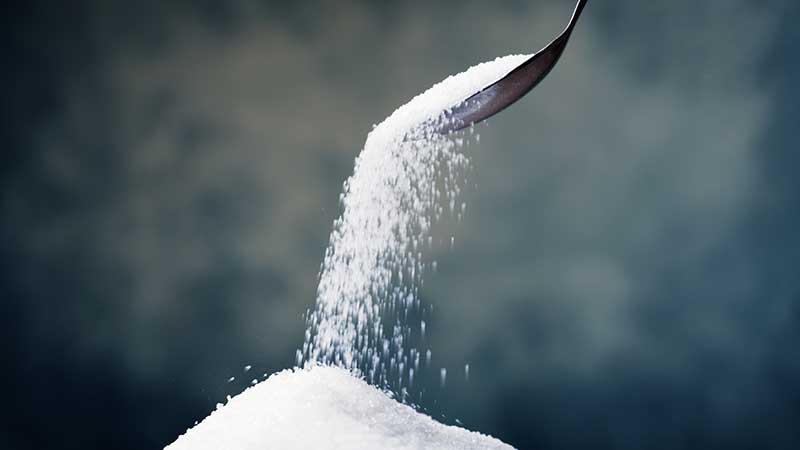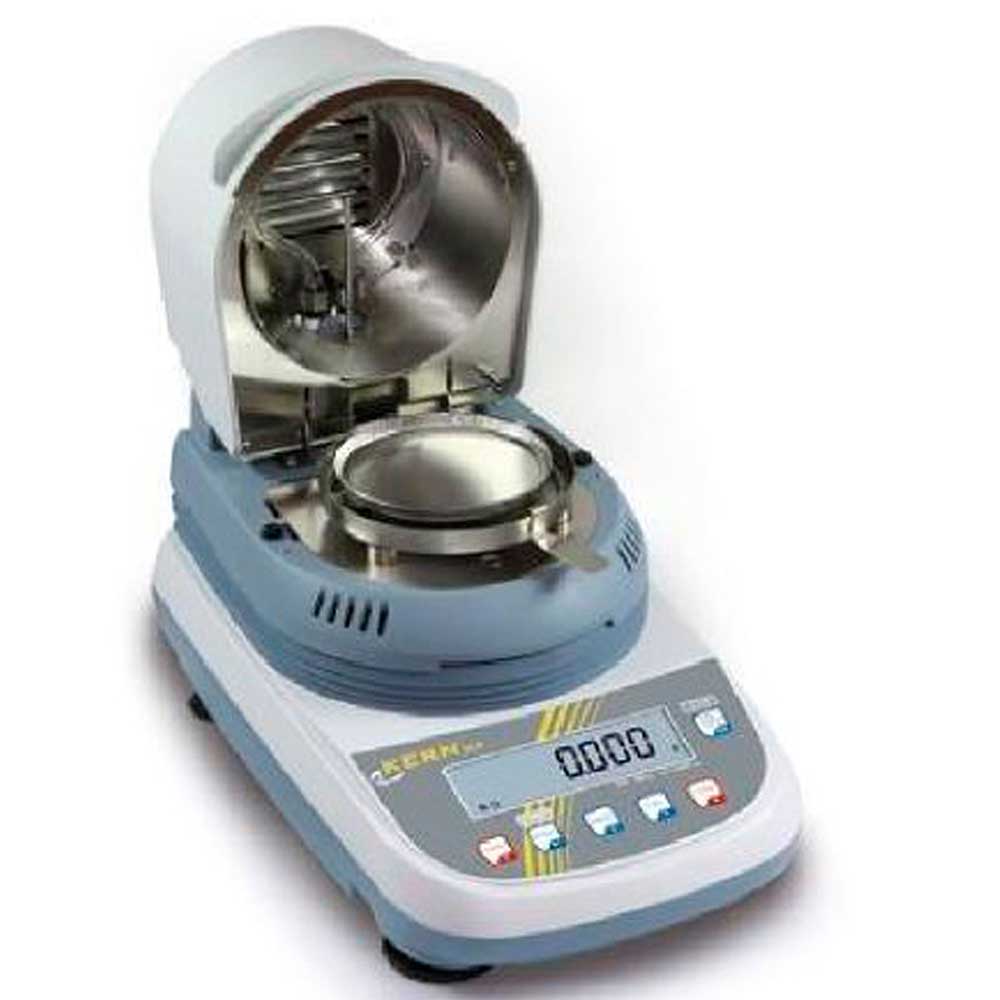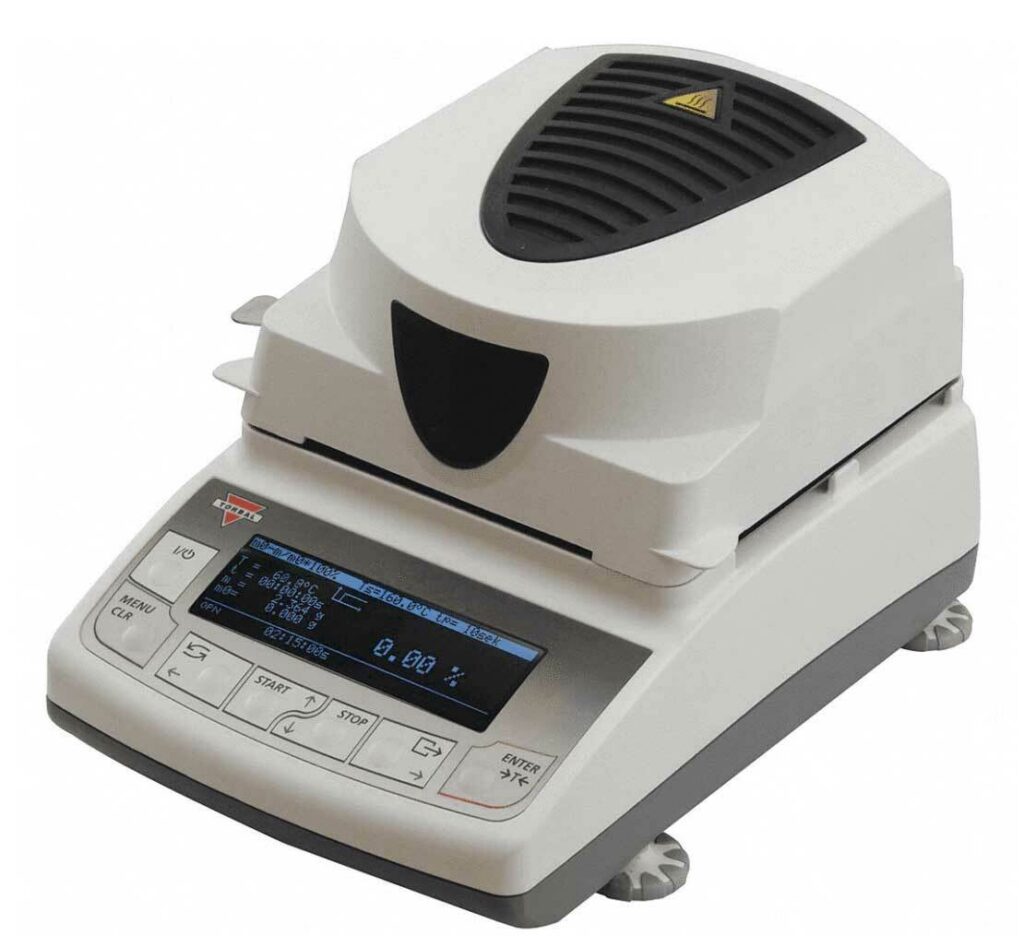
Determining and Confirming Moisture Content in Food
As reported in Wikipedia, “Food moisture analysis involves the whole coverage of the food items in the world because foods are comprising a considerable amount of water rather than other ingredients.” Food Technology notes “Both moisture content and water activity… are important in formulating products for safety and stability.” This post describes how benchtop moisture analyzers are critical tools to determine and confirm correct moisture content in food.
What is Moisture Content?
Moisture content applies to much more than food. Here is a brief explanation of the various forms of moisture that applies across the board:
- On the surface of a sample. This can be defined as bulk water attracted to other substances. Even though you might not see it, it can be there and its presence affects the weight of the substance. Surface moisture is most easily removed in a moisture analyzer.
- In pores or capillaries, where it more difficult to remove. Absorbed moisture can be inside the substance particle (think wet soil) or in tiny capillaries or crevices of roughly-shaped substances. Generally evaporating this type of moisture takes more time than required to remove surface moisture.
- Water molecules that are chemically bonded with other molecules as water of crystallization or as hydrates or adhesively bound water chemically bonded to a material at the molecular level.
Why Moisture Content in Food is Important
Consumers purchasing food by the pound are also paying for moisture content, typically water, which is an inexpensive ingredient to bring up the weight. While not good for the buyer, added water works in favor of the seller. That is why there are legal and labeling requirements for the amount of water that must be present.
Health is another reason. Microorganisms thrive in a wet environment. Drying foods helps retard microorganism growth. An example is beef jerky that is dried to prevent spoilage. On the other hand, moisture can have a positive influence on food texture, taste and appearance.
As a final example, moisture content has an influence on food processing procedures.
What is the Correct Moisture Content in Food?
Moisture content is a quality control criterion. Laws as well as industry trade associations define the correct moisture content for a broad range of products.
Let’s take sugar as an example. The correct moisture content for Grade A refined sugar is set at 0.04% maximum by the International Commission for Uniform Methods of Sugar Analysis (ICUMSA).
Or hazelnuts: According to Oregon Hazelnuts “Natural hazelnut kernels contain between 4% and 6% moisture; dry-roasted kernels contain 2-3% moisture
Sun dried raisins? In this process the sun’s heat is used to lower grape moisture content from a typical 78% down to not more than 18% as stated in the United States Standards for Processed Raisins.
Agricultural products such as grains and the flour derived from grains provide an illustration of where a moisture analyzer is put into play. A University of Minnesota Extension Report, for example, states that wheat and barley grain must have a moisture content of 13% to 14% for safe storage.
Determining and Confirming Moisture Content in Food
These examples beg the question how do you determine then confirm the correct moisture content in food.
In both cases, benchtop moisture analyzers come into play. Scientists in food labs run a series of experiments using a moisture analyzer (also called a moisture balance) to determine the optimum moisture content of a food product.
This provides guidance for commercial scale food processing lines where large drying ovens are used to adjust moisture content of the product to the recommended levels.
And to support quality control, benchtop moisture analyzers are used to confirm that commercial scale drying ovens deliver product at the recommended moisture content, or that adjustments must be made in the processing line.
And as a final check, moisture analysis can be performed just prior to product packaging.
Moisture Analyzers Explained
Moisture analyzers are programmable benchtop laboratory instruments used to measure the moisture content of small samples of products being manufactured or processed. As noted above, moisture analysis can be performed prior to, during, or after processing just before product packaging.
These laboratory units combine an analytical balance with a heater to drive off moisture from products being tested.
Most benchtop moisture analyzers today operate on what is called the thermogravimetric principal – that is determining the lost of weight on drying (LOD).
The loss represents the amount of moisture given off during the drying process while the change in weight is recorded by the analytical balance.
Testing procedures are programmed into to the moisture balance and the change in weight is continually calculated as it performs the drying operation. Because of small sample sizes the analysis can be accomplished very quickly.
Drying temperature is supplied by either infrared or halogen heaters with the latter technology being most prevalent because it can be used to determine the moisture content of virtually any substance. It is also faster than infrared drying.
For a more detailed explanation on moisture balances please see our post on how to choose a moisture analyzer.
Examples of Moisture Analysis Applications
Following are four applications to determine moisture content in food. Note that these procedures are simplified examples. You should follow established industry or government procedures when conducting moisture analysis exercises. Equipment manufacturers may provide suggested analysis procedures in their user manuals.
Moisture Analysis for Crystal Sugar
Crystal sugar will quickly absorb moisture from the environment. Moisture analysis should be made as soon as possible after it is taken from a container.
Here is an example of how the Kern DLB 160-3A moisture analyzer can be used to confirm the moisture content.
- Program the moisture analyzer by setting the operating criteria: 160⁰C, standard drying mode, and switch off at 5 minutes.
- Place 5 grams of sugar on the sample plate of the moisture analyzer and record the weight.
- Close the cover. The cycle begins automatically.
For record keeping the data can be transferred to a printer or PC via an RS 232 interface.
Moisture Analysis for Milled Hazelnuts
Carefully mill representative samples of hazelnuts just prior to testing. This minimizes increasing or decreasing moisture content due to ambient conditions.
Using the DLB 160-3A:
- Program the moisture analyzer by setting its operating criteria: 130⁰C, standard drying mode, and auto switch-off.
- Place 5 grams of the freshly milled hazelnuts on the sample plate of the moisture analyzer and record the weight.
- Close the cover. The cycle begins automatically.
The drying cycle should be approximately 6 – 7 minutes.
For record keeping the data can be transferred to a printer or PC via an RS 232 interface.
Moisture Analysis for Canola Seeds
By Canadian Grain Act standards, canola is considered dry for marketing once the moisture is at 10 per cent or below. However, for long term storage, canola should be at or below 8.5 per cent moisture.
Here is a representative procedure to determine the moisture content in canola seeds using the ATS60 moisture analyzer.
Establish a procedure for collecting representative samples. If you are testing canola seeds from bulk storage secure several samples from different areas. Protect samples from absorbing or giving off moisture due to ambient conditions.
Grind the seeds in a mill to allow the moisture analyzer heat to reach the inner portion. Take care that the grinding does not heat the seeds and commence the analysis immediately.
- Program the moisture analyzer for 100⁰C.
- Place a sample pan in the moisture balance and press the tare button. Evenly distribute approximately 3-4 grams of sample on the pan.
- Close the drying chamber and press the start button. During the analysis the display will indicate % moisture content, temperature, present sample weight and elapsed time.
- At the end of the test transfer data to a printer or PC for record keeping.
Moisture Content in Sun Dried Raisins
Here’s a representative analysis method for raisins that QC personnel can refine based on their particular requirements.
Because raisins have a skin they must be crushed to enable the internal moisture to evaporate during the heating process. To avoid moisture content change due to ambient conditions raisins should be prepared immediately prior to the analysis.
- Program the moisture balance for 115⁰C.
- Place a sample pan in the moisture balance and press the tare button. Evenly distribute approximately 3 grams of crushed raisins on the pan.
- Close the drying chamber and press the start button. During the analysis the display will indicate % moisture content, temperature, present sample weight and elapsed time.
- At the end of the test transfer data to a printer or PC for record keeping.
Need More Info? Contact our Scientists
Determining correct moisture content in food products is an important part of quality control across food processing lines. Benchtop moisture analyzers are a critical part of QC procedures, documenting and archiving results.
Contact the scientists at Tovatech for unbiased recommendations on selecting the correct model to measure moisture content in food products you produce and market.


